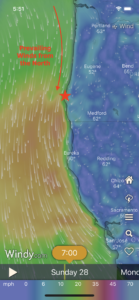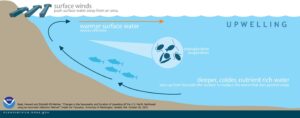Sunday, May 28, 2023 – Offshore North Pacific Coast (Latitude: 44.04.022 N, Longitude: 124.29.472 W)
Searching for Upwelling Along the North Pacific Coast!

Upwelling cycles are a collaborative effort between Earth’s atmosphere, hydrosphere, and lithosphere; also referred to as the air, water, and land. When atmospheric winds blow along coastal boundaries, they can generate Longshore currents in the ocean or currents that run along the shore. [See Figure 3.] Longshore currents facilitate the processes that allow for deep-water currents to rise toward the surface. Upwelling currents bring colder nutrient-rich water up along the coastal shelves and shoreline edges as the longshore currents allow warmer surface waters to be pushed away from the shore, [See Figure 4.] As noted in yesterday’s post, the phytoplankton the PUPCYCLE II scientists are investigating are found near the sunlit surface layers of the ocean and need these upwelled nutrients to survive and reproduce. Scientists use a variety of data formats to assist them in locating regions of the ocean most favorable for upwelling sites. These technologies and the Aquatic Food Web will be discussed in tomorrow’s log.

